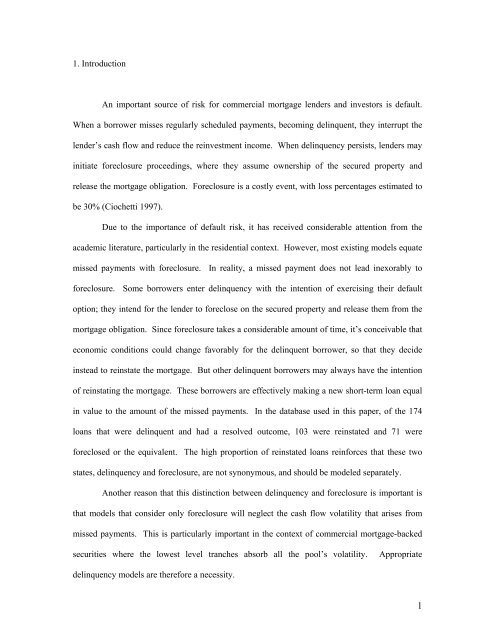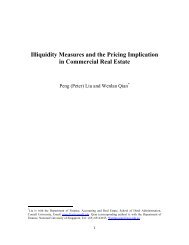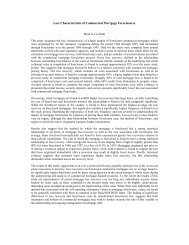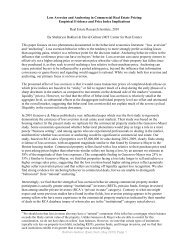Commercial Mortgage Delinquency, Foreclosure and Reinstatement
Commercial Mortgage Delinquency, Foreclosure and Reinstatement
Commercial Mortgage Delinquency, Foreclosure and Reinstatement
You also want an ePaper? Increase the reach of your titles
YUMPU automatically turns print PDFs into web optimized ePapers that Google loves.
1. IntroductionAn important source of risk for commercial mortgage lenders <strong>and</strong> investors is default.When a borrower misses regularly scheduled payments, becoming delinquent, they interrupt thelender’s cash flow <strong>and</strong> reduce the reinvestment income. When delinquency persists, lenders mayinitiate foreclosure proceedings, where they assume ownership of the secured property <strong>and</strong>release the mortgage obligation. <strong>Foreclosure</strong> is a costly event, with loss percentages estimated tobe 30% (Ciochetti 1997).Due to the importance of default risk, it has received considerable attention from theacademic literature, particularly in the residential context. However, most existing models equatemissed payments with foreclosure. In reality, a missed payment does not lead inexorably toforeclosure. Some borrowers enter delinquency with the intention of exercising their defaultoption; they intend for the lender to foreclose on the secured property <strong>and</strong> release them from themortgage obligation. Since foreclosure takes a considerable amount of time, it’s conceivable thateconomic conditions could change favorably for the delinquent borrower, so that they decideinstead to reinstate the mortgage. But other delinquent borrowers may always have the intentionof reinstating the mortgage. These borrowers are effectively making a new short-term loan equalin value to the amount of the missed payments. In the database used in this paper, of the 174loans that were delinquent <strong>and</strong> had a resolved outcome, 103 were reinstated <strong>and</strong> 71 wereforeclosed or the equivalent. The high proportion of reinstated loans reinforces that these twostates, delinquency <strong>and</strong> foreclosure, are not synonymous, <strong>and</strong> should be modeled separately.Another reason that this distinction between delinquency <strong>and</strong> foreclosure is important isthat models that consider only foreclosure will neglect the cash flow volatility that arises frommissed payments. This is particularly important in the context of commercial mortgage-backedsecurities where the lowest level tranches absorb all the pool’s volatility. Appropriatedelinquency models are therefore a necessity.1





